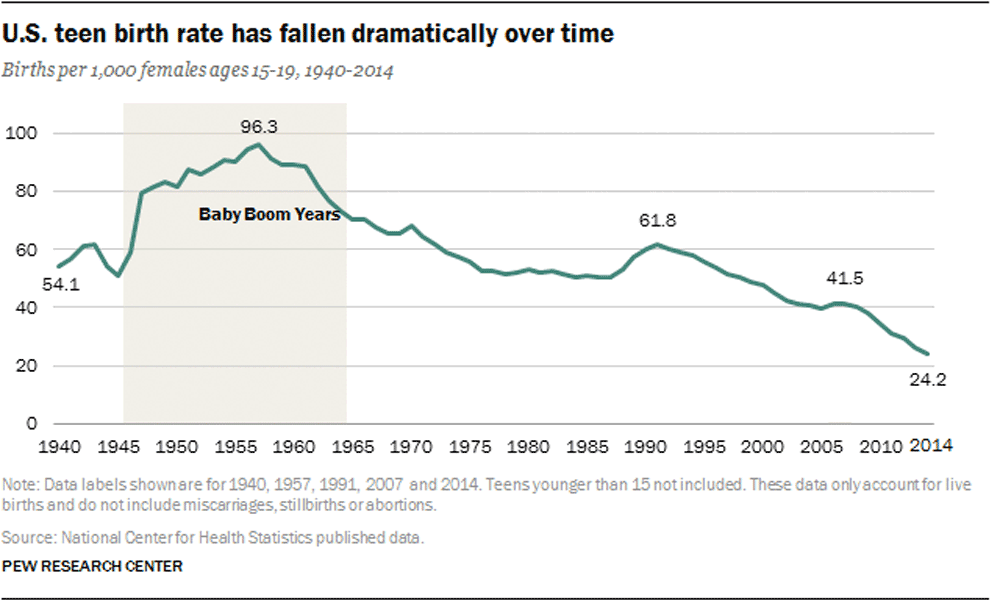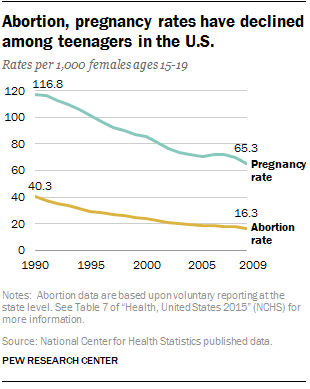Why is the teen birth rate falling?
May 7, 2016
![]() By Eileen Patten and Gretchen Livingston
By Eileen Patten and Gretchen Livingston

The teen birth rate in the U.S. is at a record low, dropping below 25 births per 1,000 teen females for the first time since the government began collecting consistent data on births to teens ages 15-19, according to a new report from the National Center for Health Statistics.
Nonwhite and younger teens have led the way in declining birth rates in recent years. Since the most recent peak in 2007, the birth rate among all teens has dropped by 42%. The declines among Hispanic (50%), Asian or Pacific Islander (48%) and black (44%) teens have outpaced this national average, while the decline among white teens (36%) has been somewhat more modest. Birth rates among younger teens ages 15-17 have also fallen faster – dropping by 50%, compared with a 39% decline among older teens ages 18 and 19.
Birth rates among nonwhite teens declined more than among whitesAlthough the teen birth rates among blacks and Hispanics have fallen faster than among whites, the racial disparity in teen childbearing remains wide. Hispanic and black teens ages 15-19 had birth rates at least twice as high as the rate among white teens in 2014. Asians and Pacific Islanders had the lowest teen birth rate – less than half the rate among whites.
 The peak for teen births was 96.3 per 1,000 in 1957, in the midst of the Baby Boom, after having risen dramatically following the end of World War II. But the composition of teen mothers has changed drastically since then. Back in 1960, most teen mothers were married – an estimated 15% of births to mothers ages 15-19 were to unmarried teens. Today, it has flipped: 89% of births are to unmarried mothers in that age group.
The peak for teen births was 96.3 per 1,000 in 1957, in the midst of the Baby Boom, after having risen dramatically following the end of World War II. But the composition of teen mothers has changed drastically since then. Back in 1960, most teen mothers were married – an estimated 15% of births to mothers ages 15-19 were to unmarried teens. Today, it has flipped: 89% of births are to unmarried mothers in that age group.
The teen birth rate has been on a steep decline since the early 1990s, and that trend accelerated during the recession of 2007-09 and the years following, reversing a brief uptick that began in 2006. What’s behind the recent trends? One possible factor is the economy: A Pew Research Center analysis tied the declining birth rate to the flailing economy. And birth rates for teens fell faster than they did for all females ages 15-44 from 2007 to 2014 (42% and 9% declines, respectively).
What else is contributing to the decline in teen birth rates? Less sex, use of more effective contraception and more information about pregnancy prevention.
Abortion, pregnancy rates have declined among teenagers in the U.S.For one thing, there has been a significant decline in the percentage of never-married teenage females who report that they have ever had sex, from 51% in 1988 to 44% in 2011-13, according to National Survey of Family Growth data. Furthermore, among never-married teens who have had sex, 79% of girls and 84% of boys used a contraceptive method the first time they had sex.
While the overall share of teens using contraception at first sex has not changed significantly, the use of some forms of highly effective contraceptive methods is increasing. The share of sexually active teen girls who have used emergency contraception (e.g., the morning-after pill) rose from 8% in 2002 to 22% in 2011-13. And a CDC analysis of the roughly 600,000 low-income teens who use a Title X Family Planning program for contraception found that the use of long-acting reversible contraceptives (LARCs), such as IUDs and implants – which are considered more effective than other means of contraception – rose from 0.4% in 2005 to 7.1% by 2013.
Pregnancy prevention programs and messages directed to teens may also have played a role. A 2014 Brookings report found that the MTV programs 16 and Pregnant and Teen Mom, reality TV shows that follow the struggles of teen mothers, may have contributed to up to a third of the decline in teen births from June 2009, when they began airing, through the end of 2010.
 It’s worth noting that birth rate figures only include live births, and do not account for miscarriages, stillbirths or abortions. In 2009, the estimated pregnancy rate for teens was 65.3 pregnancies per 1,000 females ages 15-19 (36.4 among those ages 15-17 and 106.3 among those ages 18-19).
It’s worth noting that birth rate figures only include live births, and do not account for miscarriages, stillbirths or abortions. In 2009, the estimated pregnancy rate for teens was 65.3 pregnancies per 1,000 females ages 15-19 (36.4 among those ages 15-17 and 106.3 among those ages 18-19).
But teen pregnancy rates have fallen, too. Looking at data reaching back to 1976, the pregnancy rate peaked among teens ages 15-19 in 1990, at 116.8, and had fallen 44% by 2009. The abortion rate among females ages 15-19 has also fallen over roughly the same time period – from 43.5 per 1,000 female teens in 1988 to 16.3 in 2009. Of the roughly 700,000 pregnancies among teens in 2009, about 58% are estimated to have ended in live births, 25% in abortions and 17% in miscarriages or stillbirths.
Eileen Patten is a research analyst focusing on Hispanic, social and demographic trends at Pew Research Center.




























